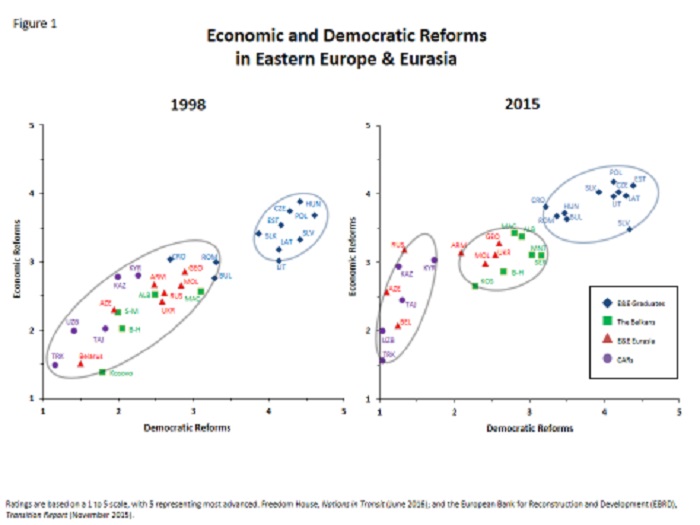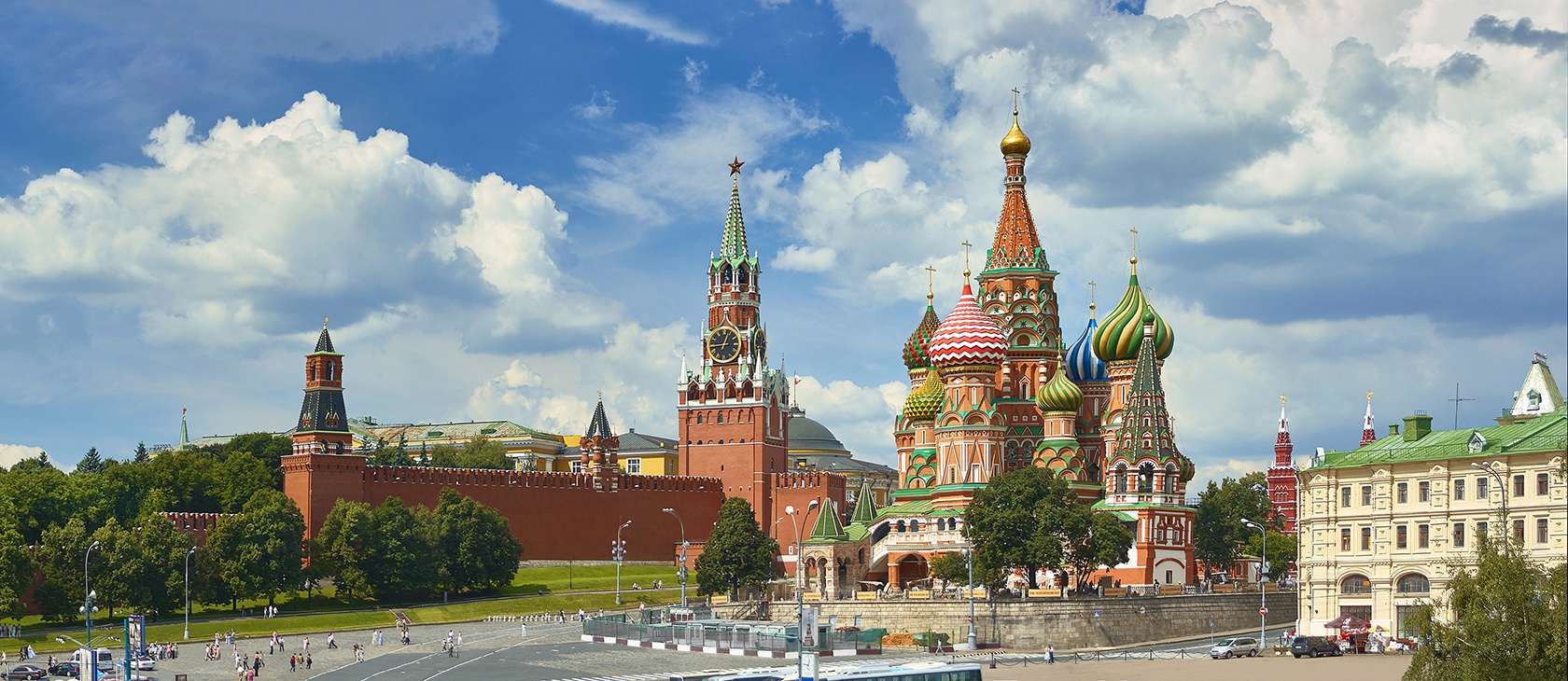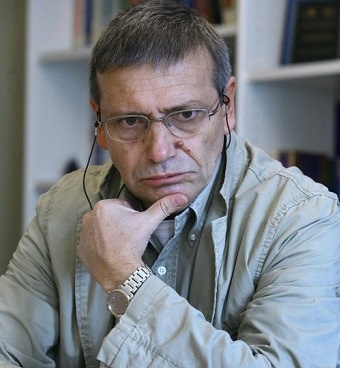In April, the World Bank published a working paper titled “Communism as the Unhappy Coming.” It is co-authored by two my fellow Bulgarians, Simeon Djankov (whom I have known well for years; we worked together) and Elena Nikolova. They have concluded that members of the Eastern Orthodox Church, the second-largest church in Christendom, are likely to support left-wing economic policies. The report states that “relative to Catholics, Protestants, and non-believers, those of Eastern Orthodox religion have less social capital and prefer old ideas and safe jobs.” Further, “Orthodoxy is associated with left-leaning political preferences and stronger support for government involvement in the economy.” The report was soon picked up by Bloomberg News and The Economist.
It is probably true that historically Orthodox countries (the study lumps in believers and non-believers alike) would fall into the group of those supporting greater government intervention in the economy. This has been the case in the last decade in Russia and, before 2008, it would have held true for Serbia and Montenegro. But the implied causality between Orthodoxy and economic policy is premised upon the authors’ tacit assumption that many of Orthodox and/or Catholic nations remained Christian throughout their Communist occupation.
Communism as a state 'religion'
In reality, no Communist government from Pyongyang to Tirana respected religious freedom, or failed to persecute the faithful and expropriate church property. The destruction of the Russian Orthodox Church began at the end of 1917. In January 1918, the Red Army tortured and killed Metropolitan Vladimir of Kiev in the first shocking case of Communist terror against the Orthodox Church.
It failed to bring cash into the treasury, but by the end of 1922 no fewer than 1,200 priests had been executed.
In 1921, Lenin and Trotsky vowed to put the monasteries “under peasants’ and workers’ control.” In reality, Lenin hoped that the looting of churches would bring the government “several hundred million gold rubles” to settle Russia’s foreign debts. Trotsky coined the slogan “turn gold into bread,” as if the funds would fight the famine that the Bolsheviks themselves caused. This policy was “legalized” by a secret decree (“On Liquidation of Church Property”) on January 2, 1922. It failed to bring cash into the treasury, but by the end of 1922 no fewer than 1,200 priests had been executed. Many more were forced to leave Russia or were sent to the Gulags. (For more, see Sean McMeekin, The Russian Revolution: A New Story. New York: Basic Books, 2017, pp. 231-334.) Until the fall of the Soviet Union, most of the surviving churches were turned into warehouses or museums; one of them, the magnificent Kazan Cathedral in St. Petersburg, inspired by St. Peter's Basilica in Rome and known as the Romanovs’ family church, became the Museum of the History of Religion and Atheism. Ultimately, as Nikolai Berdyaev noted in The Russian Revolution, Karl Marx was viewed as virtually a god and the State worshiped as instrument of class struggle (and the inflictor of terror). Some countries still have mummified past Communist leaders on display in the main squares of their capitals, and people still stand in line to meet the Communist idols-in-the-flesh.
On pages 11 and 12, the authors describe Lenin’s policy of persecution:
The Soviets deprived the Orthodox church of its legal status and the right to own property. Teaching religion was banned in private and public schools … In response, Patriarch Tikhon of Moscow excommunicated the government. The Soviet leadership retaliated by killing many bishops, lower clergy and monks: in the next five years, 28 bishops and 1,215 priests were killed, and 8,000 monks perished in 1922 alone … The number of Russian Orthodox churches dropped from 54,000 in 1914 to 7,500 in 1966.
Yurii Kuznetzov (a Russian economist, mathematician, and thoughtful Orthodox Christian), cited publications reasonably estimating that, from 1917 to 1953, more than half-a-million Soviet Orthodox subjects (members of clergy and their families) became “New Martyrs.” Of these, 80,000 vanished only in 1937. (The persecution of clergy and believers softened in the post-Stalin years but continued unabated until the 1980s.)
The incumbent patriarch of Russia and a number of high-ranking Russian clergy were KGB agents. Their role in facilitating Marxism was recently summarized for the English speaking audience by Spyridon Mitsotakis: They celebrated Stalin as almost equal to Jesus (although they had no icons of him in their churches); 700 Synod members that elected the patriarch of Moscow in 2009 were members of the secret KGB cohort; his predecessor, Patriarch Alexy II, had a KGB codename “Drozdov,” and was awarded the highest honors for his service to the state.
The Bolshevik destruction of Orthodoxy was copied by their postwar marionettes in other countries, the difference being one of degree. Until 2015, 11 out of the 15 members of the Holy Synod of the Bulgarian Orthodox Church, including the patriarch, were collaborators with the Bulgarian analogue of the KGB. (This fact is mentioned in passing by none other than Djankov and Nikolova.) In fact, the planned destruction of religion (and its servants and institutions) was replicated by the Bolsheviks in all Soviet republics (e.g. two Georgian patriarchs were killed by them), and by all Communist countries, irrespective of whether their population belonged to the Orthodox, Roman Catholic (the two Christian churches well covered by Djankov-Nikolova’s paper), Armenian, Muslim, or Buddhist tradition.
The Russian Orthodox Church’s alliance with the government has hardly slackened since the fall of the Berlin Wall. Ten years ago, as part of a Liberty Fund colloquium on “Liberty, Markets, and Orthodox Christianity,” I investigated and found the following: In 48 out of 49 websites affiliated with bishops and archbishops I found links to “partner-organizations” that were extreme nationalists or even quasi-fascist political parties and movements. The only site without such partners was that of the patriarch. This is not to say that there no profound and true Christian theologians and believers in Russia – to the contrary. After a year, I revisited the same list of websites, those links had been removed.
To quote Berdyaev again, “The Orthodox Church had its moments of historical sin, for the most part in connection with its external dependence on the State, but the Church's teaching, her inner spiritual path was not subject to distortion” (Truth of Orthodoxy, 1952). Djankov and Nikolova refer to many authors who recognize that sin. The problem, however, is the bridge which they construct between the Byzantine imperial era of church dependence on government and contemporary political sentiments.
Comparing bicycles with elephants
Methodologically the authors approach is off-base in this respect: One must be cautious combining opinion polls results (the World Value Surveys, WVS) with the expert assessment of Transition Progress by the European Bank for Reconstruction and Development (EBRD), an analogue of the World Bank for the post-Communist countries. These data and indicators cover recent periods and cannot be used, from a methodological standpoint, to claim a causal relationship or even path-dependence (a direct impact of past cultural, political, and policy choices on contemporary affairs) between religious backgrounds and contemporary economic policies.
... had the Soviet citizens been surveyed in 1970s, they would have been shown to be great supporters of the market economy, as proven by the flourishing black market.
This runs the risk of comparing bicycles with elephants. Judging from its data archive, the WVS only began polling Orthodox countries after 1995. (Only the Russian Federation was polled earlier, in 1992.) The years of central planning are totally missing from WVS, which developed to the level of global coverage only in the late 1980s. But the Marxists adore using state power as an instrument of class struggle. Gia Jandieri – a Georgian economist, pro-market reformer, and a believer – told this author that, had the Soviet citizens been surveyed in 1970s, they would have been shown to be great supporters of the market economy, as proven by the flourishing black market.
What matters most in evaluating post-Communist countries is when free-market reforms were launched; the intellectual penetration of the Marxism; how quickly and robustly the nation evolved from central planning to the market; and, to a degree, the countries’ geographical distance from Russia and the former Soviet Union (FSU).
In 2015, a special IMF report on the 25-year transition from Communism found the more rapid and sweeping the nation’s first years of post-Communist reforms, the likelier its success and prosperity. In the ex-Yugoslavian countries, Albania, and in the FSU, the ancient regime collapsed two-to-three years later than in countries that later joined the EU, the so-called “New Europe.” By mid-1995, the ex-Yugoslavian states except for Macedonia were marred by wars, which then were repeated in 1999 and 2001. Military conflicts broke out on the periphery of the Russian Federation – such as the so-called Transnistria, the Northern Caucasus, in Nagorno-Karabakh, in 2008 in Georgia (an Orthodox nation), and recently in Eastern Ukraine – and could break out again at any moment. No wonder that Djankov and Nikolova find out that, on average, Orthodox WVS respondents are less happy than Roman Catholics or Protestants.
The chart below is borrowed from a presentation by Strategic Planning and Analysis Division of USAID to a regional conference in Sarajevo (September 2016). It applies a method similar to that of Djankov-Nikolova, highlighting average scores of all post-Communist countries of Europe and FSU in democratic (Freedom House) and economic (EBRD transition indicators) reforms between 1998 and 2015.

It shows that some “late reformers” like Orthodox Romania and Bulgaria (where rapid liberalization was reversed in the period from 1995 to 1997), or Catholic Croatia (which was effectively at war until 1995) – have tended to move over the years closer to the rapid reformers of Central Europe and the Baltic countries. This happens irrespective of wars, dictators like Milosevic in Serbia or Tudjman in Croatia, NATO’s bombing of Serbia, and of the imperfect political traditions of these countries. On the other hand, Russia and the countries of the former USSR, many of them predominantly Muslim, tend to remain where they were 20 years ago.
Perhaps the reason for this performance has little to do with the nation’s dominant religious tradition and more to do with its economic and political integration with the free and prosperous West. For instance, the ex-Yugoslavian countries and Albania signed free trade agreements with the EU in 2001, thus initiating the longest period of GDP-per-capita growth of their history as sovereign states. But Russia and the members of the Eurasian Customs Union (since 2001) and the Eurasian Economic Union (EEU, since 2014) demonstrate the opposite trend: Member countries, whether Orthodox or Muslim, lost comparative advantages and income due to Russia’s dependence on natural resources (and, perhaps, political shortsightedness).
History bites
The actual experience of the Orthodox Church, especially during the Ottoman period, is very different from the impression Djankov and Nikolova give their readers.
Orthodox monasteries were economic centers that owned or managed large estates – in that respect, not much different from the Benedictine monasteries of Western Europe. Some evidence of this (treasury rules, accounting books, etc.) may be found in the monasteries of Mount Athos, Rila Monastery in Bulgaria, or Orthodox monasteries in modern-day Kosovo. The monastic institutions in the eastern Mediterranean under Mamluk rule in the eleventh-to-fourteenth century preserved peace, performed rudimentary banking, and served as important educational centers.
Orthodox Christianity does not uphold an economic system, which rewards laziness and encourages the poor to depend upon handouts from the state.
The classic work of Traian Stoianovich, an American historian of Serbian decent, The Conquering Balkan Orthodox Merchant (1960) proves that from the fourteenth or fifteenth through the eighteenth century, Orthodox merchants created regional prosperity. They also operated under business-friendly regulations (or “constitutional economic arrangements,” in the parlance of modern institutional economists) of the kings appointed by the sultans. In the nineteenth century, Orthodox merchants invested in the Suez Canal, some of them making a fortune and becoming the founders of the most prosperous families in their respective countries in the second half of the nineteenth century. In the late eighteenth and early to mid-nineteenth century, Balkan Orthodox merchants inspired or even organized successful tax rebellions throughout the empire. In modern Greece, there were at least three low-tax jurisdictions preserved by the Ottoman authority. Ironically, the post-Ottoman Orthodox states’ taxes were much higher than under the sultan.
The government was more active in Eastern European Orthodox countries (leaving aside the Russian Empire, which is a special case) after gaining independence from the Ottomans – but this had nothing to do with religious values. Greece accumulated its government debt and even defaulted during its war of independence in the 1820s – and then three more times in the nineteenth century – mostly due to its enormous public sector. As newly formed countries, they had to build and keep relatively large armies, accumulated government debts, and most of them needed had to pay the High Port for the refugees (Turks and Moslems who left for the Ottoman Empire, or modern-day Turkey) and the infrastructure. For instance, Baron Hirsch Railways of the Ottoman Balkans was commissioned by the sultan’s government to build a railway from Istanbul to Vienna; in order to finish and keep it, the newly independent governments borrowed money and imposed relatively high taxes. On the top of that, Bulgaria had to pay the Russian Empire the costs of the 1877-1878 war that eventually made possible the creation of the Bulgarian state. Paying that sum took about 20 years and, at times, the debt payments consumed as much as 10 percent of its GDP. Due to a deficient border arrangement and inter-Balkan animosities, wars – often financed and inspired by the Russian imperial diplomacy – frequently marked the region’s early history. By the end of World War I, Bulgaria had one of the largest armies in the world, both in terms of regular and conscripted military personnel as share of the population. All of this necessitated high taxes and a larger public sector.
Djankov and Nikolova refer several times to Max Weber’s The Protestant Ethic and the Spirit of Capitalism. Yet Weber was cautious in linking causes with effects. He rather maintained that Protestantism created the climate for modern capitalism and never associated it with a particular country. Twenty-five years ago in his The Catholic Ethic and the Spirit of Capitalism, Michal Novak proved that this climate also exists in the modern Catholic world.
Few people note that the first counterpart to Weber was written by Russian Orthodox theologian Sergei Bulgakov. His 1909 essay on “The National Economy and the Religious Personality,” first published in English by the Acton Institute, explains how and why Orthodox values fueled the Russian industrial revolution and aided entrepreneurship even under the autocratic rule of the tsars. Bulgakov noted, “Surveys of Russian industrial history, in relation to spiritual biographies and the everyday life and circumstances of pioneer entrepreneurs, would have discovered the religious-ethical foundations of the psychology of Russian industry.”
As recently as 2005 the Rev. Irinej Dobrijevic who is now a Bishop of the Serbian Orthodox Metropolitanate of Australia and New Zealand, wrote his own ground-breaking vision of “The Orthodox Spirit and the Ethic of Capitalism.” Contrary to our authors, Father Irinej collects convincing set of arguments that “Orthodox Christianity does not uphold an economic system, which rewards laziness and encourages the poor to depend upon handouts from the state.”
The World Bank paper by Simeon Djankov and Elena Nikolova misses the important contributions made by the Orthodox values, faith, and institutions to the development of free markets and the liberal democratic order. In that sense, Orthodox believers are not significantly different from the rest of Christian believers.




